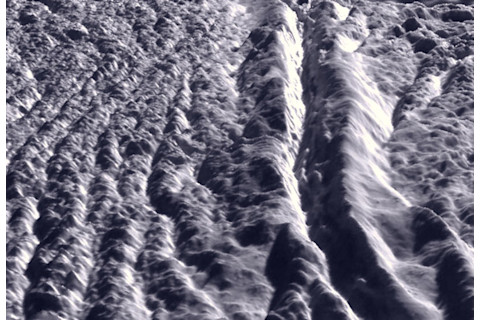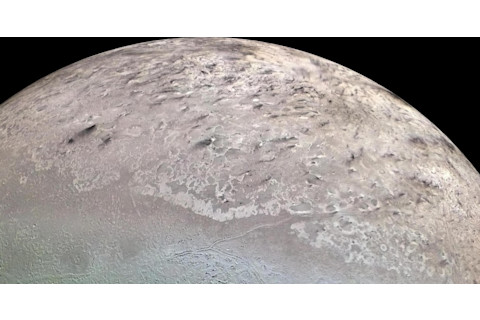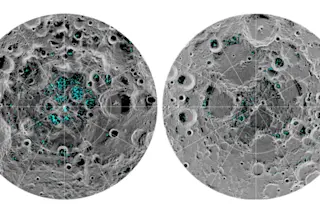Yes, there is water on the Moon.
Twenty years ago, evidence of frost-coated regions near the Moon’s poles was greeted with surprise and skepticism. Ten years ago, a NASA instrument aboard India’s Chandrayaan-1 space probe greatly boosted the case for water ice on the Moon. Then two weeks ago, a much deeper analysis of the Chandrayaan-1 data validated the surprise and ended the skepticism: Some permanently shadowed “cold-trap” craters near the lunar poles clearly do contain regions that are up to 30 percent water ice.
Lunar ice could be a precious resource for future explorers, a potential source of drinking water and oxygen as well as raw material for rocket fuel. The Moon’s poles are now beckoning targets for further exploration. There’s also a broader message to the discovery of ice on the Moon. Ice, frost, and snow are ubiquitous all across the solar system. Water ice is especially abundant, but every large world across the solar system seems to have frost of some form — even in the hottest and most unlikely places.
You could hardly pick a more unlikely place for ice than Mercury, the innermost planet. It orbits the Sun at just over 1/3rd Earth’s distance. It’s daytime temperature can hit 430 degrees Celsius (800 Fahrenheit). Yet during the 1990s, astronomers bouncing radar signals off of the planet noticed bright reflections from the polar regions. The signals were consistent with water ice tucked away in craters that, like the polar craters on the Moon, never get exposed to sunlight. As a result, temperatures there might never rise above -170 degrees C (-275 F), cold enough to keep water ice in stable cold storage. Recent data from NASA’s Messenger probe confirm that there’s ice on Mercury — quite a bit of it, in fact.
The origin of the ice remains a mystery, but the leading theories are that it could have been deposited by comet impacts, or that it could have formed locally from hydrogen atoms in the solar wind binding with oxygen atoms in surface rocks. Those are the likely mechanisms for the ice on the Moon as well. Soon we will know more. The European-Japanese BepiColombo probe, scheduled to launch later this year, will give Mercury a much closer look. And both NASA and the Chinese National Space Administration have expressed keen interest in assessing the potential watery resources at the lunar poles.

The high-altitude Maxwell Montes region of Venus appears bright in radar images, most likely because of a coating of heavy metal snow. (Credit: NASA/JPL)
OK, there is one planet even less likely to have frost than Mercury. On Venus, the heat is even more intense (a steady 460 degrees C), and it is relentless; because of the thick atmosphere, there are no protected craters or other hiding spots. Water ice is impossible under those conditions, but other kinds of frost and snow can form under the extreme Venusian conditions. Here again, the first clue came from radar images. Highlands on Venus appear unexpectedly shiny. Something is brightening up those regions–but what?
The leading theory is that high-altitude regions are dusted with metallic frost, most likely composed of lead sulfide and bismuth sulfide. These molecules might boil out of rocks at lower altitudes or, more plausibly, could be belched out by intermittent volcanic activity and circulate through the atmosphere. Venus is so hot that even metallic compounds would stay vaporized close to the ground. They would freeze out only on relatively cool, high mountains. It’s fitting that a hellish planet would be dusted with a glittery layer of heavy-metal snow.
Continuing outward from the Sun, there’s no doubt that water frost is abundant on planet #3, Earth. The fourth planet, Mars, also wears its ice prominently, although the planet’s famous polar caps contain frozen carbon dioxide (aka dry ice) in addition to frozen water. The exciting news from Mars is that some of its water appears not to be frozen solid. A huge underground lake of liquid water appears to exist in the south polar region of the planet; it’s a promising new place to search for life.
On Jupiter and Saturn, there is plenty of ice and snow, but it takes on unfamiliar forms. Both planets are cold up top but hot on the inside. At a boundary level in the atmosphere, water can melt and condense, creating water clouds and snowstorms — although the water is probably mixed with ammonia, making it more like a Windex storm. There’s also no solid surface where snow can collect, so falling flakes just get remelted, evaporated, and sent back into an endless cycle.

Cloud towers rise 50 kilometers above Jupiter’s lower cloud decks in a dramatic image taken by NASA’s Juno probe in May, 2017, from a distance of 12,900 kilometers. (Credit: NASA/SWRI/MSSS/Gerald Eichstadt/Sean Doran)
NASA/SWRI/MSSS/Gerald Eichstadt/Sean Doran
Jupiter is warmer and more active than Saturn, so the ice clouds there are more visible and dramatic. Last year, NASA’s Juno probe got an exceptionally good look at a stormy day on Jupiter, with high clouds casting clear shadows (shown above).
Water ice in solid, more tangible form is abundant on many of Jupiter and Saturn’s moons. If you are looking specifically for snow and frost, however, Enceladus is your destination of choice. This little Saturnian satellite is most famous for the extensive (and potentially life-sustaining) ocean hidden beneath its frozen exterior. Water from that ocean squirts out in jets at Enceladus’s south pole. Water from the jets immediately freezes and snows down onto the surface in a fine powder: perfect for skiing, according to Paul Schenk of the Lunar and Planetary Institute.

The snowy ridges of Enceladus, as imaged by the Cassini spacecraft in 2008. (Credit: NASA/JPL/SSI/USRA/LPI)
NASA/JPL/SSI/USRA/LPI
By the time you get out to Uranus and Neptune, temperatures are so cold that any water-ice clouds form deep in the atmosphere. If there’s any conventional snowfall going on, it’s happening out of sight. The white clouds that show up in Voyager images of Neptune and in more recent ground-based views of Uranus are from patches of methane cirrus.
There’s more interesting activity on Neptune’s big moon, Triton, however. When Voyager 2 flew by in 1989, it observed dark plumes drifting across the landscape. Jets of nitrogen gas, heated by the distant Sun, apparently ejected flakes of material — perhaps water mixed with organic compounds — which then drifted down onto the surface, contributing to Triton’s odd, streaked appearance.

Triton’s dark streaks show were something (unknown) erupted from below and then snowed down onto the surface. (Credit: NASA/JPL/USGS)
NASA/JPL/USGS
No discussion of ice in the solar system would be complete without Pluto, perhaps the iciest world of them all. On Pluto, water ice is so cold and hard that it forms the bedrock of the surface. Nitrogen ice collects into soft glaciers that flow down the mountains and accumulate in giant, squishy, slowly churning plains. Methane adds another intriguing icy element. It falls out of the extremely thin atmosphere as fine flurries, capping the water-ice mountains with a dusting of unearthly frost.
One striking lesson from this tour through the solar system is that frost and snow are everywhere. The substances and circumstances change depending on temperature, pressure, and composition, but as long as there is even a trickle of energy there will be some kind of frost cycle. The other lesson is just how abundant water is. Venus stands out as one of the few places where water is not commonplace on the surface or in the clouds.
The ingredients for life on Earth are not rare at all. It’s the arrangement that makes our planet so precious and — until proven otherwise — unique.
For more cosmic news and insights, follow me on Twitter: @coreyspowell














